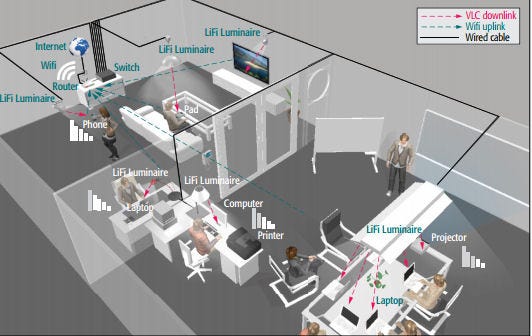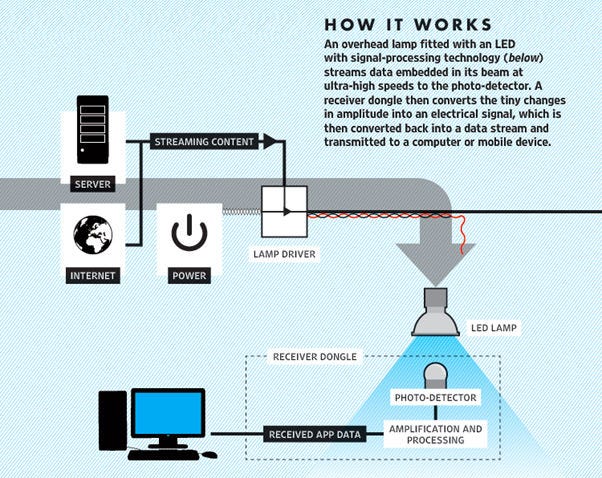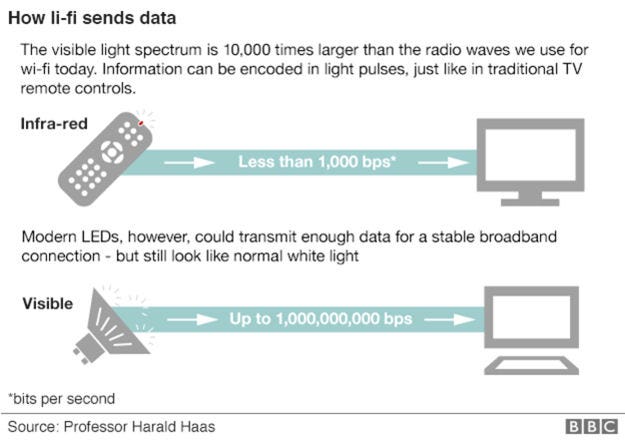What is Li-Fi and how can it improve 5G communications?
The key principle of this technology is that instead of radio waves, light is transmitted, using a LED and a light detector as the receiver, which could be placed in the phone, camera, tablet or PC.
August 18, 2016

Telecoms.com periodically invites expert third parties to share their views on the industry’s most pressing issues. In this piece Natalia Molinero Mingorance of behindthesciences.com looks at the emerging technology of Li-Fi and examines its viability for commercial use.
Nowadays there are many ways in which cell phones can connect to Internet by switching between the 3G, 4G and Wi-Fi services. However, these systems can be easily saturated in places where there is a high user density. Li-Fi is a complementary system that has been studied for more than 100 years and data would be transmitted in frequencies between the 400 and 800 THz, the visible light spectrum. The aim of Li-Fi is to send information through conventional lighting elements (LEDs) at the same time that a place is illuminated, by adding a small number of devices that would have a very low cost.
In addition, the increase in the number of applications and the amount of data that will be required for 5G has introduced a key concept for the next generation: HetNets, specially focused on providing high QoS in indoor environments where the demand is greater. One of the candidate technologies to satisfy these requirements is the combination of Wi-Fi and Li-Fi which could coexist, although some authors had predicted that Li-Fi would replace Wi-Fi.
Wi-Fi has evolved into WiGig, providing higher speeds by using the unlicensed 60 GHz band,. WiGig tri-band enabled products are commercially available in the bands of 2.4, 5 and 60 GHz. However, some authors think that Wi-Fi protocols are not robust enough to support the higher traffic demands of 5G, due to the protocol contention. In addition, when used indoors, the different types of walls in a building cause attenuation, which is translated into low speeds perceived by the users. Another common weakness of Wi-Fi is the easily-caused interference between Access Points (AP). Therefore, the CSMA/CA protocol needs improving: not considering the channel state information to provide connectivity priority seems to be a disadvantage in comparison with 4G protocols. Li-Fi would improve indoor connectivity by off-loading the traffic from Wi-Fi, but this would be restricted to static users. Let’s have a look at the technical details of Li-Fi so we can create our own judgement.
The following picture shows a HetNet proposition [1] where VLC refers to the Li-Fi technology:

Li-Fi Technology
The origin of the interest in this technology is attributed to Harald Hass, professor at the University of Edinburgh. He is co- founder and CSO of pureLi-Fi, which introduced the first commercial Li-Fi system, Li-1st, in the Mobile World Congress of Barcelona, in 2014.
The key principle of this technology is that instead of radio waves, light is transmitted, using a LED and a light detector as the receiver, which could be placed in the phone, camera, tablet or PC.

Source: Pure Li-Fi.
There are still several candidates considered for Single Carrier Modulation (SCM) schemes for Li-Fi: OOK, PPM, PAM, a variant of PPM, Variable Pulse Position Modulation (PPM) and a variant of QAM. Among the Multi Carrier (MC) modulation schemes considered, Direct Current Optical OFDM (DCO-OFDM) and Asymmetrically Clipped Optical OFDM, are the main techniques. In addition, there are Li-Fi specific modulation schemes (see the references to know more about all these modulation schemes).
Among the key benefits of introducing Li-Fi as a complementary LAN technology, we find:
Most bulbs can transmit data through light (transmission rate may vary from bulb to bulb)
There are no frequency regulations
Li-Fi provides more security than Wi-Fi in the sense that light doesn’t pass through walls
The last advantage is a limitation at the same time, because it’s not possible to interconnect different Li-Fi APs, so the range is limited to short distances.
In November 2015, some promising tests were performed by the start-up Velmenni (Tallinn) where they showed that Li-Fi bulbs transmit 1 Gbps in an office environment while the laboratory tests showed theoretical rates of 224 Gbps (100 times faster than Wi-Fi).

The CEO of the start-up, Deepack Solank, said that this technology can reach consumers in 3 or 4 years.
Conclusion
There are still many open question such as the cost of a Li-Fi system, which some companies such as Sisoft have estimated from 25 to 400 euros, while Harald Hass said that the price would be a 10% of the Wi-Fi system price. In addition, the Li-Fi Consortium and the Li-Fi Center need to establish rules so all the manufactures can agree in the production and specifications of the system. Finally, there is a bit of controversy regarding to the applications of Li-Fi and if it will be a substitute or a complement for Wi-Fi.
Sources:
[1] M. Ayyash, et al. “Coexistence of Wi-Fi and Li-Fi Toward 5G: Concepts, Opportunities, and Challenges”, IEEE Comunications Magazine, pp. 64-71, February 2016.
[2] H. Haas et al., “What is Li-Fi?”, IEEE Journal of Lightwave Technology, pp. 1-12, 2015.
[3] IEEE Std. 802.15.7-2011, IEEE Standard for Local and Metropolitan Area Networks, Part 15.7: Short-Range Wireless Optical Communication Using Visible Light, IEEE Std., 2011.
[4] J. Armstrong and A. Lowery, “Power efficient optical OFDM,” Electron. Lett., vol. 42, no. 6, pp. 370–372, Mar. 16, 2006.
[5] K. I. Ahn and J. K. Kwon, “Color intensity modulation for multicolored visible light communications,” IEEE Photon. Technol. Lett., vol. 24, no. 24, pp. 2254–2257, Dec. 201
 Natalia graduated in Telecommunication Engineering from Spain. She came to the UK two years ago to study an MSc in Wireless Communications System and upon completion was offered a job as a Research Associate on a 5G project. She is also currently doing a PhD on the same subject and runs the telecoms sections inbehindthesciences.com blog.
Natalia graduated in Telecommunication Engineering from Spain. She came to the UK two years ago to study an MSc in Wireless Communications System and upon completion was offered a job as a Research Associate on a 5G project. She is also currently doing a PhD on the same subject and runs the telecoms sections inbehindthesciences.com blog.
Read more about:
DiscussionAbout the Author
You May Also Like


.png?width=300&auto=webp&quality=80&disable=upscale)







.png?width=300&auto=webp&quality=80&disable=upscale)


_1.jpg?width=300&auto=webp&quality=80&disable=upscale)